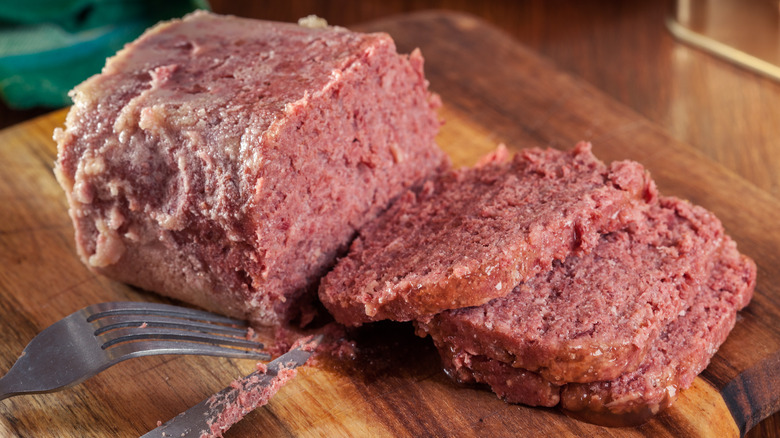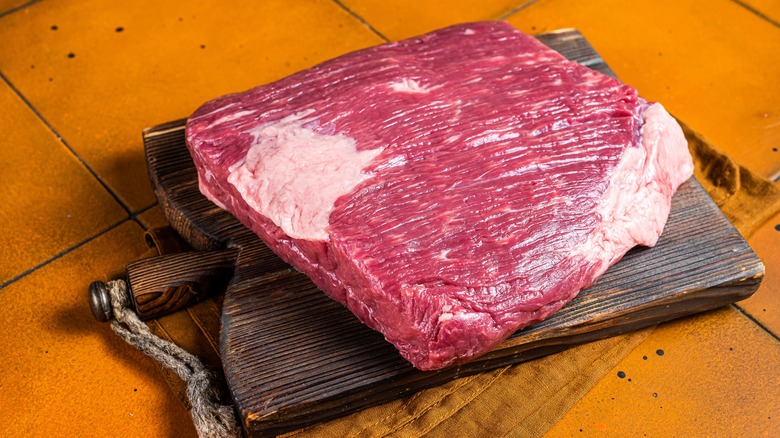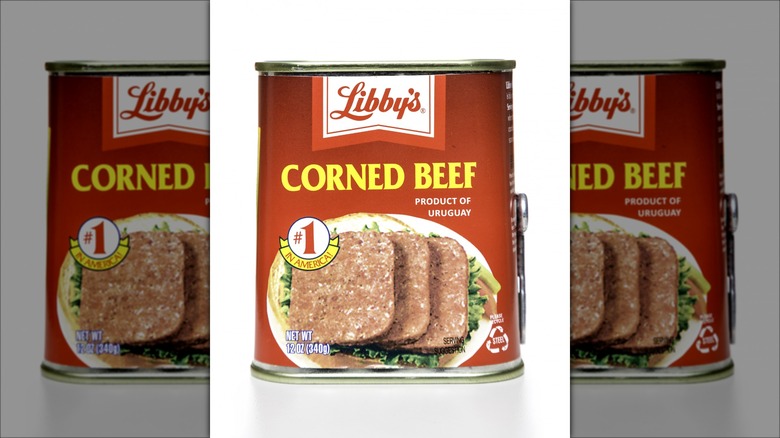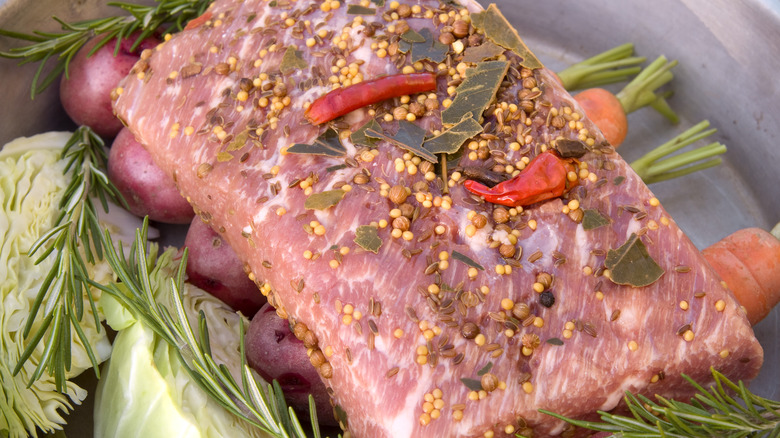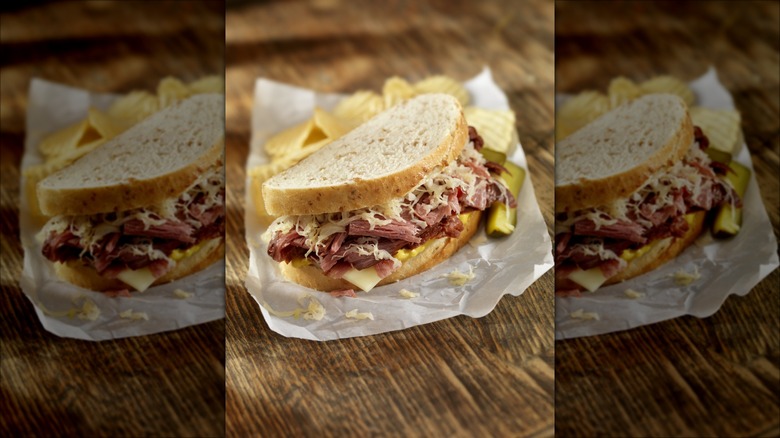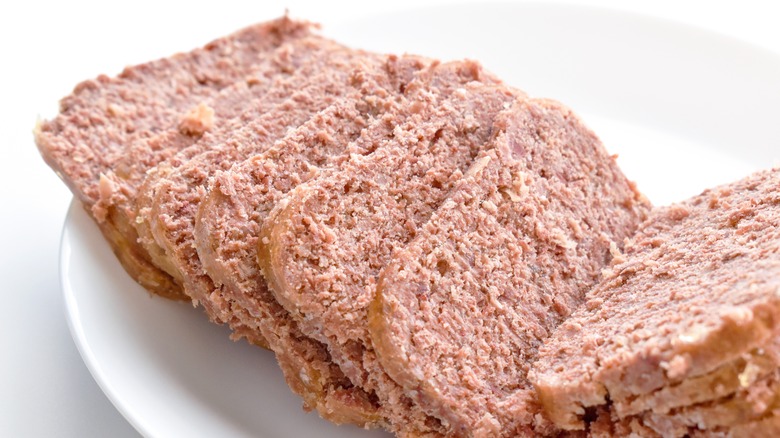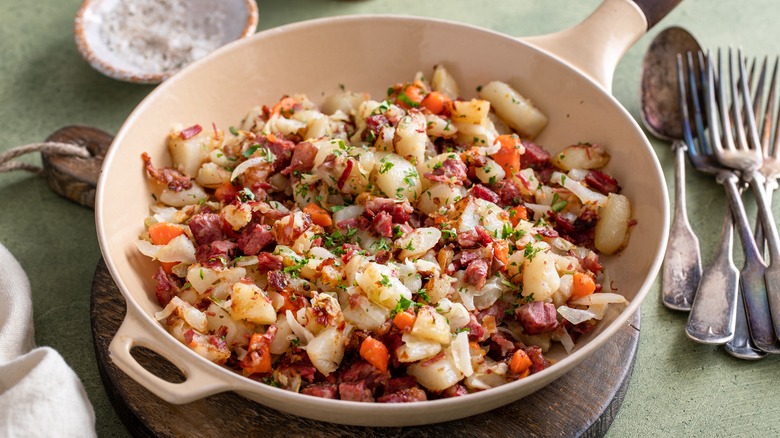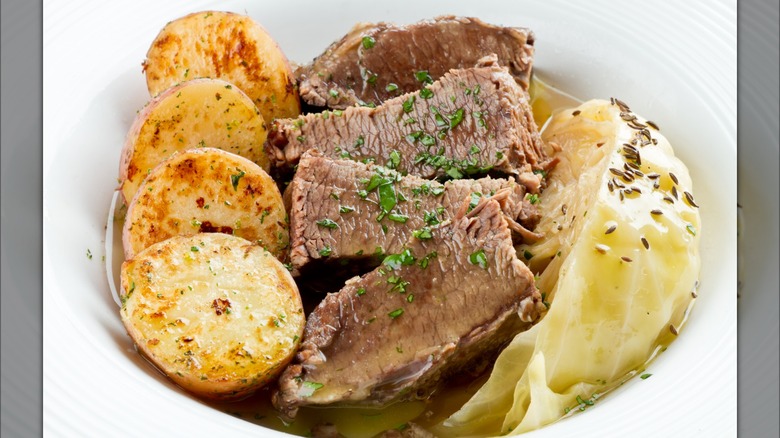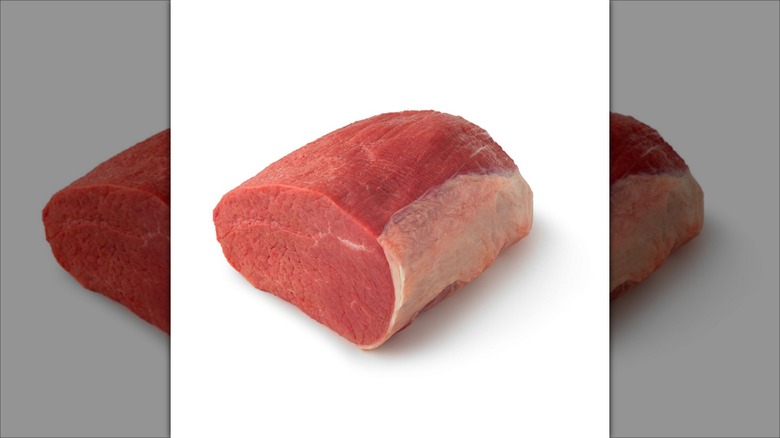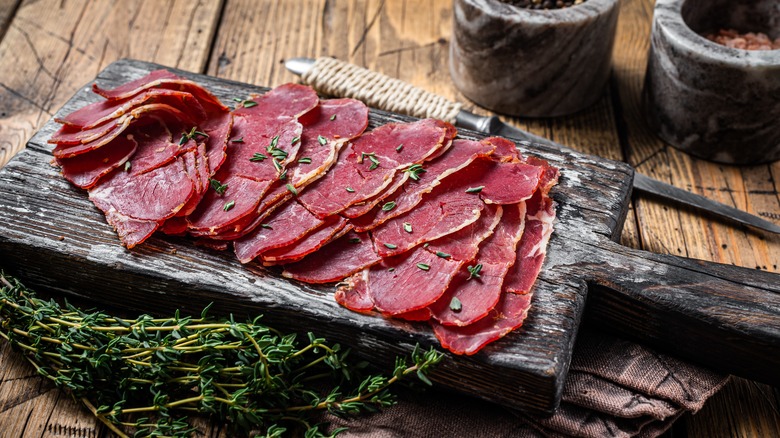What Exactly Is Canned Corned Beef & The Best Things To Make With It
St. Patrick's Day is an ode to green beer, shamrocks, and the Blarney Stone. It's also one of the days when you'll find the most excellent corned beef dishes — especially corned beef and cabbage. Much of the time, these dishes aren't made from canned corned beef, but that doesn't mean it's impossible to make traditional meals using the tinned product.
There are some practical reasons to consider going this route, not only on St. Patty's Day but also throughout the year when a hunger for that cured meat goodness strikes and won't let go. Canned corned beef is made from most of the same ingredients as its fresh counterpart, but it keeps longer in the cupboard. If you like to keep canned meats as pantry staples, you'll welcome a few tins of corned beef.
And in terms of budget, it's a steal. It typically costs less than a burger at McDonald's. Certainly, it costs less than buying a whole corned beef brisket. This option is especially welcome when you're making dinner for one. You save on expenses while still being able to enjoy your favorite corned beef recipes. If you've not tried it in a can before, this post will teach you about the similarities and differences between canned and fresh corned beef. You'll also learn about its nutritional value, possible accompaniments, and even what to eat instead if corned beef isn't your jam.
What are the ingredients in canned corned beef?
Canned corned beef qualifies as one of the wonders of the food world. It takes an otherwise tough piece of meat, the beef brisket or beef round, immerses it in a brine filled with pink curing salt and other brining yummies and comes out the other side tender and spreadable with just a fork.
The biggest wonder of all, of course, is the fact that canned corned beef actually contains no corn. The corn that's being referenced here pertains to the gigunda kernels of brining salt. Okay, probably they aren't gigunda, but large enough to be nearly corn kernel-sized, which explains the name. This preserves the beef and gives it some protection against bacterial growth and undue moisture. As for the beef itself, canned corned beef is made from tough cuts of meat, like chuck, pot roast, or rump roast. In the non-canned version, this is usually brisket, but with canned beef, this may not always be the case.
It's also worth mentioning that the pink curing salt gives the corned beef its pink color. Other than its pink hue, this salt nitrate looks like table salt, so it's definitely not the corn part of this equation. The pink color is useful, however, because it helps the common user distinguish it from table salt.
How is canned corned beef made?
From an ingredients standpoint, canned corned beef gets filled with many of the same basic kinds of ingredients, including sugar and salt, that its homemade or store deli counterparts contain. Some of the fancier, more nuanced seasonings, like peppercorns or coriander, don't make it into the canned version, but otherwise, it's pretty much the same from an ingredients standpoint.
The process for making canned corned beef is different than the made-from-scratch kind. The beef goes into a continuous cooker from whence the manufacturer eventually takes a broth. This is allowed to evaporate until a meat extract forms. The remaining beef undergoes a thorough cleaning. This clears away fatty and connective tissues. It's only then that the curing salts are poured in to do their magic. Canning and sterilization come after that.
Finally, there's one more ingredient worth talking about: sodium nitrates. Although these added preservatives occur in some foods naturally and are considered healthy in these instances, combining them with canned meat literally brings out the worst in them. Here, the nitrates bind with the meat's amino acids to create what's called "nitrosamines." Because this substance has been known to increase the odds of colorectal cancer by nearly 20%, the World Health Organization (WHO) has declared it a Group 1 carcinogen. (For reference, tobacco is also a Group 1 carcinogen.)
How does bagged deli corned beef differ?
Canned corned beef, while convenient and even tasty, doesn't always cut it come dinner time, particularly during those moments of celebration when roasted, from-scratch meat recipes would work better. St. Patty's Day celebrations are good examples of this. In these instances, corned beef lovers who are so inclined can make a homemade corned beef recipe or buy some from a local deli.
However, in the absence of the motivation to cook up corned beef completely from scratch (or find a deli that does the same), there is bagged corned beef. It comes in both corned beef brisket and corned beef round forms. Basically, these types of corned beef offerings are corned beef roasts in plastic bags. They come pre-cured, which saves time for the home cook.
Because the meat is actually still fresh, it needs to be stashed in the fridge or the freezer before preparation — unlike canned which has an almost indefinite shelf life. Although you can cook it on its own, it also works with recipes that call for tasty roasted vegetables like cabbages, carrots, and potatoes. The bagged corned beef cooks in the oven or on the stovetop in about an hour, which makes its prep time less than from scratch by several days but more than from canned by several hours. You find this version of corned beef in the meat or deli aisles.
What about homemade corned beef?
If you've ever had fantasies about eating a corned beef sandwich with a side of pickles that you've made, the good news is you can make both the corned beef and the pickles using basically the same pickling spices. The bad news is you'll be waiting at least five days before your corned beef is sandwich-ready.
But assuming that this info doesn't deter you from making your own corned beef, here's how you'll get started. Select a pot that's large enough to fit the beef brisket but small enough to fit into the fridge. Into this cauldron of Irish goodness, put the pickling spices, like pink and kosher salts, sugar, allspice berries, bay leaves, cloves, black peppercorns, and coriander seeds. Cook this on the stovetop for a bit, then stash it in the fridge.
Your brisket will take a swim in the vat for five days. (The max is seven days.) The flat cut of the brisket works best here. The meat requires a good turn every other day while it plays in its bath. Cook it in the oven at 350 F for a couple of hours. Putting it in an oven bag seals in the juices and enhances the flavor.
Clearly, the length of time it takes to make homemade corned beef represents a major drawback, one that canned corned beef corrects, at least in terms of saving you time. Homemade corned beef isn't so much difficult as it is very time-consuming.
What does canned corned beef taste like?
Given that most corned beef gets soaked in salt brine for five to seven days, one of the big flavor elements in the canned meat is saltiness. That's not all, but it's a big part of it. Canned corned beef has fewer spice varieties than from-scratch corned beef, so you may not also taste the subtle flavors of cloves, coriander, juniper, ginger, black peppercorns, and other spices and herbs that home chefs often put into their personal corned beef recipes.
Due to the cured meat in corned beef, it's not inaccurate to say that its flavor resembles a hot dog a little bit. Although it won't have the smokey flavor that bacon or ham does, certain elements within the flavor profile of the canned beef bring bacon, ham, and other cured meats to mind. This has to do with the pink curing salt that manufacturers use to make all these different types of meat.
It's also not far off the mark to say that some corned beef has all the different flavor elements: sweet, sour, salty, bitter, and umami. The flavor breakdown of each of these elements will depend on the recipe that the manufacturer used to make the canned corned beef, however. For example, canned corned beef usually contains salt and sugar but may not contain coriander, which is a little on the bitter side. In this case, then, the corned beef may not have as much of the bitter element in its flavor profile.
How to cook with canned corned beef
Cooking with canned corned beef allows corned beef fans to whip up recipes like Reuben sandwiches, corned beef hash, and corned beef casserole quickly and easily. Because the beef has quite a bit of sodium, that will flavor anything canned corned beef is cooked with. In this respect, it's best to approach recipes with this in mind, lest you add too much salt.
As far as simple dishes like sandwiches, because the meat is cooked ahead of time, it's fine to open a can, add some mayo and mustard to a roll, and top that with the corned beef, Swiss cheese, and possibly some sauerkraut. No cooking is involved unless you prefer a hot sandwich.
It's additionally worth noting that if you cook corned beef in something like a casserole, it may be necessary to cook the other ingredients, like pasta or tater tots, for example, ahead of time. While the corned beef is completely cooked, those other ingredients won't be. They'll need a little time in the oven or on the stove to get up to speed, so to speak before you add the corned beef to them.
Finally, keep this rule of thumb in mind. Anytime a recipe calls for leftover corned beef, you can use canned corned beef most of the time, which opens up the possibilities for the different types of recipes you can make with canned corned beef.
What are some popular side dishes with corned beef?
While canned corned beef pretty much always tastes great, people rarely eat it by itself. Instead, they fill their plates with the likes of cabbage, corn on the cob, carrots, and other nummy side dishes. There are no rules that state what exactly people should eat with their corned beef. However, there are some foods that people love to eat with this meat.
Because of the food traditions of St. Patty's Day, cabbage is often the dish that comes immediately to mind as far as side dishes for corned beef, canned or otherwise. Home chefs cook cabbage, along with carrots and potatoes, in their corned beef. And while this is most often the case with corned beef roast, cabbage is a popular side regardless. Cabbage's savory fermented cousin, sauerkraut, plays a big role in the Reuben sandwich, along with its Swiss cheese, rye bread, and Russian or Thousand Island dressing. When it's eaten on its own, biscuits, string beans, Brussels sprouts, colcannon potatoes, carrots, and other canned corned beef side dishes complete this popular meal.
Where to buy canned corn beef
Finding canned corned beef is as easy as going to your neighborhood store or logging on to your favorite online retailer. A number of different retailers carry canned corned beef, as well as related products like corned beef hash. For example, as of the time this article was written, you could find the Libby's brand of canned corned beef on the Fred Meyer website. The price for that runs $6.99 while Kroger brand corned beef hash goes for $4.29.
A trip to Walmart offers a few brand options — Libby's, Hereford, and Great Value for $5.67, $4.92, and $3.54, respectively. Corned beef hash runs between $2 and $3, depending on the brand. Amazon also offers a number of brands of corned beef, including Libby's for $5.99. Online consumers also have the option of buying a six-pack of Hereford brand for $46 and Ox & Palm onion-flavored canned corned beef for $5.78. Amazon additionally offers a Halal-friendly version of canned corned beef for $5.96 from Iberia brand.
Nutritional information about canned corned beef
From a nutritional standpoint, eating canned corned beef has the potential to fill the body with some much-needed nutrients. One serving of canned corned beef, which is two ounces, gives your body 13 grams of protein. To offer some context, that's about one-quarter of the recommended daily allowance for a 50-year-old woman, who requires around 53 grams of protein a day, according to Harvard Medical School. It also offers 8% of the daily allowance for iron.
On the flip side, due to the brining process, canned corned beef comes with a lot of sodium, nearly 550 milligrams per serving. It also has a good amount of fat — 8 grams on average. Because of how it's prepared, it's nearly impossible to avoid the large amounts of sodium, though some brands like Hereford do make a lower-sodium version of their corned beef. Opting for that version of the canned meat instead of the regular version reduces sodium intake for the day by 25%.
Different varieties of corned beef
As far as variety goes, canned corned beef delivers. Most corned beef comes from brisket or beef round. However, the labels on many canned corned beef products don't specify what kind of beef the manufacturers use, meaning that it could be made from either brisket or round (or any other cut of beef for that matter).
But that isn't all. While many canned corned beef recipes offer only corned beef in brine and sugar, some companies, like Ox & Palm, have additional flavors, like onion or chili and garlic. Other companies, like the Iberia brand, carry special dietary designations, such as "halal." For corned beef fans who like a little substance to their canned corned beef, it's possible to find chunky-style, too.
For more nuanced recipes that include other spices, like coriander, ginger, and ground black pepper, usually bagged corned beef or homemade corned beef present better options. It's likely that you can also find more nuanced corned beef recipes at your local deli or butcher, too.
How to store canned corned beef
Like most canned products, this one, left unopened, will last until the next ice age or thereabouts. This is the beauty of the canning process in action. Granted, barring an unexpected shift in the speed of the changing epochs, canned corned beef doesn't last millennia, but it's not unreasonable to expect it to be still edible for two to five years from whenever you buy it. There is a caveat, of course. The can must remain unopened and unbroken. The can's "best by" date (or something similar) indicates how good the food tastes once you open it. It may taste less-than-fresh, but it won't harm you to eat it provided that there is no damage to the can.
Once you open the can, the deterioration process starts. According to the United States Department of Agriculture, it's okay to stash canned food in the fridge in the can that it came in. For the best taste results, it's better to put the opened canned corned beef in a plastic or glass container. It should be consumed within four days of opening. Canned meat, like SPAM (and presumably, canned corned beef), works in frozen form, too, provided that you freeze it after you open it. Freezing any kind of unopened canned goods can cause the can to burst open and ruin the food inside. If you accidentally freeze it in the can, throw it out.
What can I eat instead of canned corned beef?
For food nerds who think that canned corned beef is the best thing since, well, sliced bread with a little corned beef and cheese inside, it may be difficult to fathom not liking this popular meat. However, some would prefer to eat something else for lunch. Fortunately, several viable substitutes exist for canned corned beef, though not all of them are available as canned meats.
Pastrami qualifies as the closest substitute and offers a viable option for people who do actually like corned beef but, for whatever reason, can't get it. Beef is the main ingredient in both. However, pastrami can be made with brisket, deckle, or navel, whereas corned beef is usually made with brisket. And they even start with similar brining processes and brining ingredients.
However, after being subjected to the brine bath, pastrami gets mustard and fennel seeds, brown sugar, garlic, peppercorns, and coriander massaged into it. Eventually, it goes into the smoker before it makes its way to its final home between two slices of bread slathered with mustard. The smoking process gives it a memorable and tasty crust that helps the taste buds to further distinguish between these two types of meat. Other options for meat substitutes include roast beef, shepherd's pie, ham, and even vegan corned beef for those who don't want to eat animal foods at all.
